Texas Highway Patrol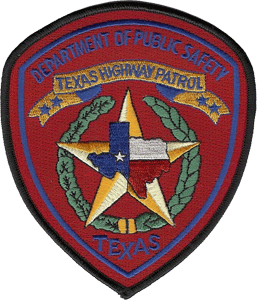
Texas Highway Patrol
In the late 1920's Texas began to experience a deterioration of the state's bridges and highways from overweight and unregulated truck traffic and the state legislature knew it was time to form an organization dedicated to enforcing existing traffic legislation.
The Texas Highway Department was thus authorized to hire 18 license and weight inspectors and one chief inspector. After only 2 years, the License and Weight Section was increased to 50 men and renamed the State Highway Patrol.
By 1931, that number increased to 120 men. On August 10, 1935, the Texas Department of Public Safety was formed to properly organize law enforcement of all levels in the Lone Star State, and the Highway Patrol as well as the legendary and renowned Texas Rangers were incorporated into the new Texas DPS.
In 1957, a reorganization of the DPS took place. The state was divided into 6 regional commands, each headed by a senior officer with the rank of major and responsible to the director. Field personnel of the Highway Patrol, Motor Vehicle Inspection Service, Communications and Safety Education Service were placed under regional commanders.
The Texas Rangers also followed suit with a company following the same boundaries as the regional commands. Today, the Texas Highway Patrol falls under the Traffic Law Enforcement Division of the DPS. The Texas Highway Patrol Division is responsible for general police traffic supervision, traffic, and criminal law enforcement on the rural highways of Texas.
The Division’s goal is to help maintain public safety through the efficient and effective administration of the division's various programs.
The only confirmed use of license plates on Texas DPS vehicles goes back to 1935 where a blurry period photo shows an F-prefixed passenger car license plate used. Texas EXEMPT license plates for DPS vehicles were confirmed used by 1937, but given the fact that some period photos also depict DPS vehicles running passenger car license plates from that time into the 1940s, it's entirely possible that they also used EXEMPT plates as far back as 1932 when EXEMPT license plates were introduced in Texas.
As you will see as you scroll down the page, the lion's share of Texas Exempt license plate photos were provided by Don Cantello. Don is the author of a book on Texas license plates titled: "Of Time and Plates" and has graciously permitted these photos to be shared here in our mutual goal to preserve and promote license plates and their place in motoring history.
Many of the photos he provided were furnished by contributors to his book, where their names can be seen in the credits section of that publication.
If you have a deeper interest in Texas license plate history in general, Don can be reached at RMC-DD@hughes.net
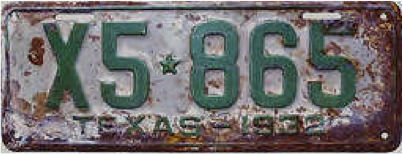 1932 EXEMPT series issue.
1932 EXEMPT series issue. 
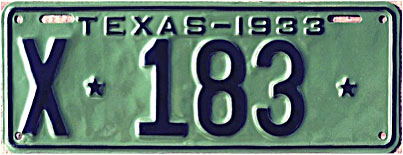 1933 EXEMPT series issue.
1933 EXEMPT series issue. 
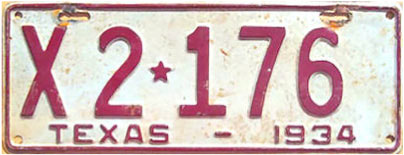 1934 EXEMPT series issue.
1934 EXEMPT series issue. 
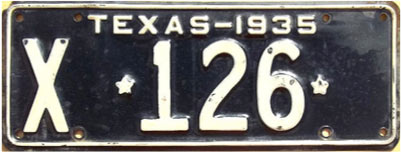 1935 EXEMPT series issue.
1935 EXEMPT series issue. 
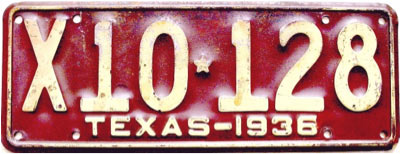 1936 EXEMPT series issue.
1936 EXEMPT series issue. 
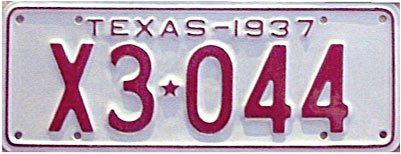 1937 EXEMPT series issue.
1937 EXEMPT series issue. 
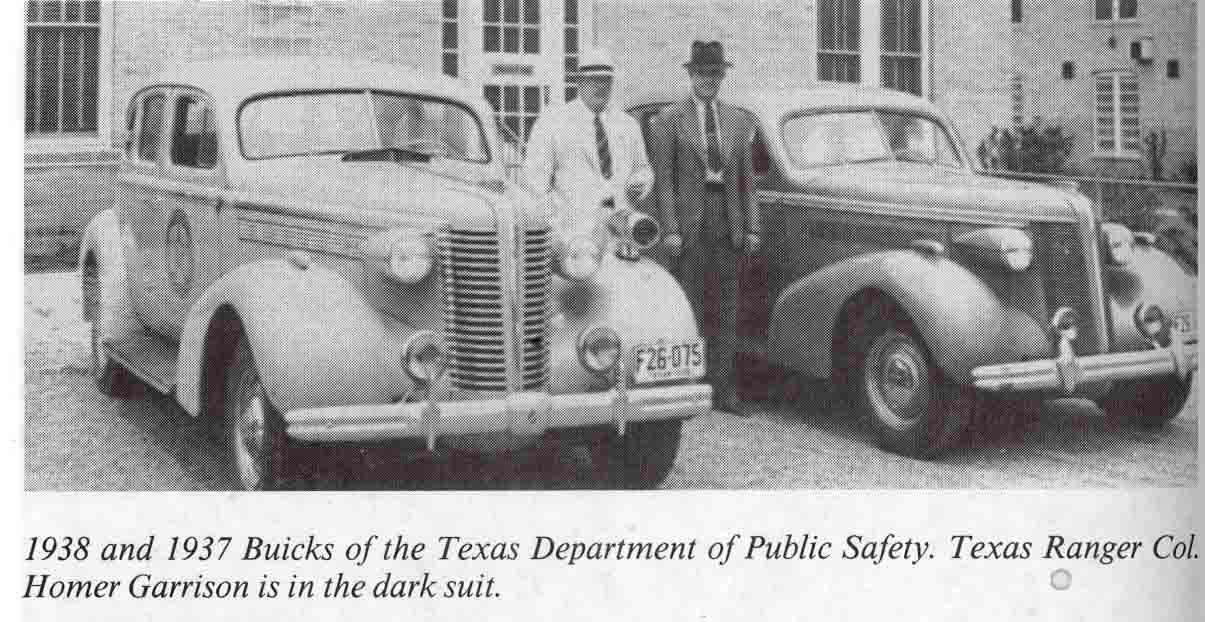 1938 Texas F-prefix passenger plates on both these Texas DPS vehicles. The use of passenger series plates were interspersed with the use of Exempt plates during this time. A fully marked Texas HP car is seen in the gallery displaying a 1938 F-prefix passenger car plate as well. (Courtesy James Creech)
1938 Texas F-prefix passenger plates on both these Texas DPS vehicles. The use of passenger series plates were interspersed with the use of Exempt plates during this time. A fully marked Texas HP car is seen in the gallery displaying a 1938 F-prefix passenger car plate as well. (Courtesy James Creech) 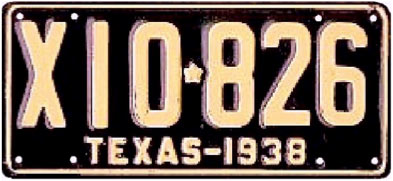 1938 EXEMPT series issue.
1938 EXEMPT series issue. 
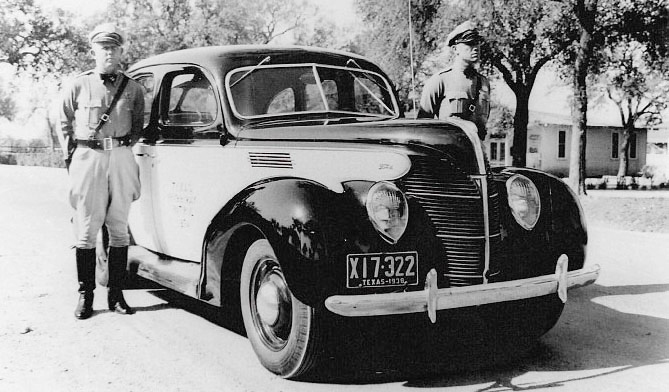
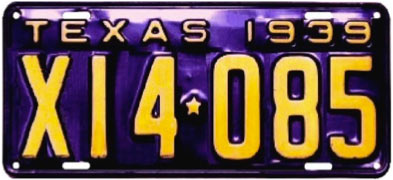 1939 EXEMPT series issue.
1939 EXEMPT series issue. 
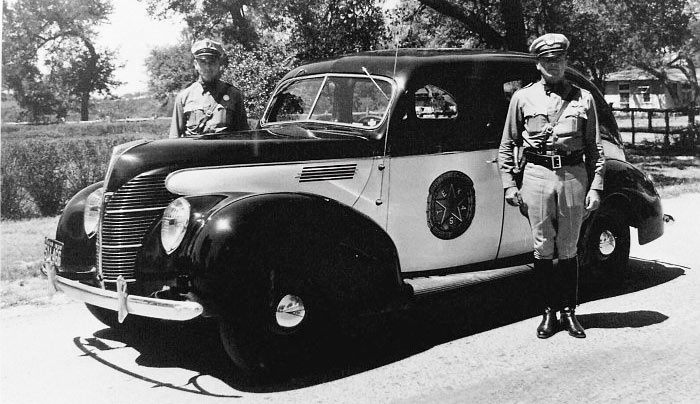
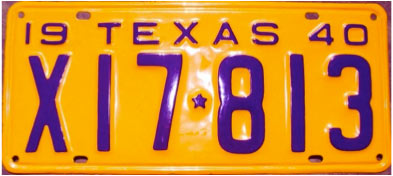 1940 EXEMPT series issue.
1940 EXEMPT series issue. 
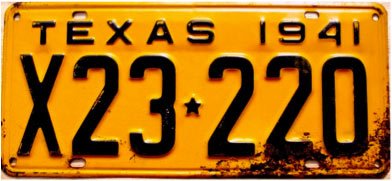 1941 EXEMPT series issue.
1941 EXEMPT series issue. 
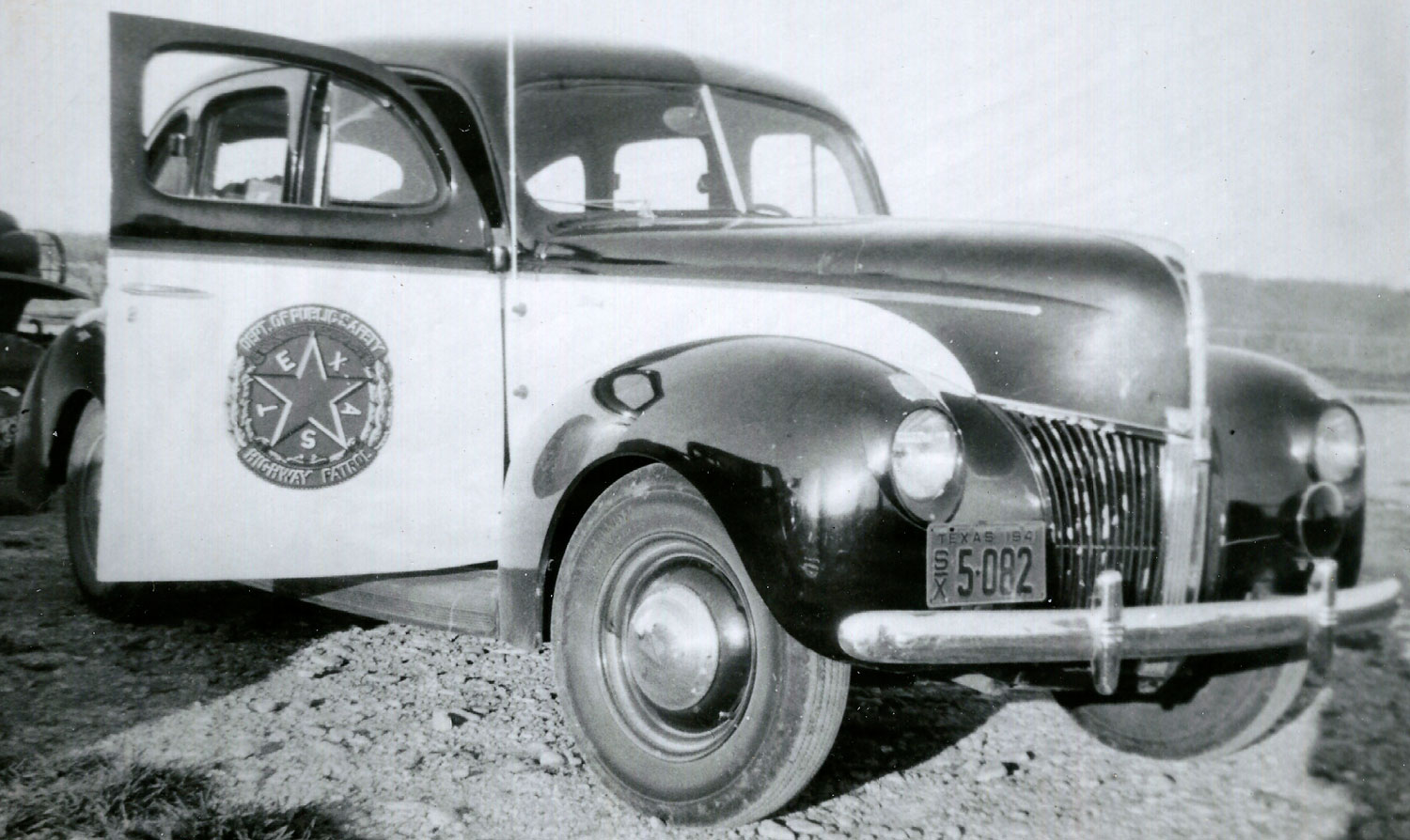
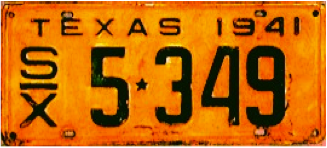 1941 STATE EXEMPT series issue. Embossed steel.
1941 STATE EXEMPT series issue. Embossed steel.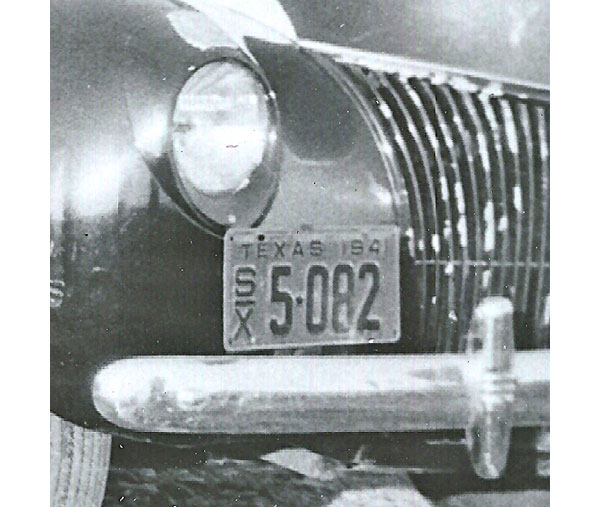
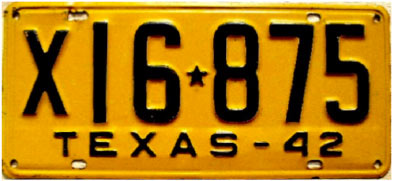 1942 EXEMPT series issue.
1942 EXEMPT series issue. 
 1943 tab attachment. Embossed steel.
1943 tab attachment. Embossed steel. 1944 tab attachment. Embossed steel.
1944 tab attachment. Embossed steel.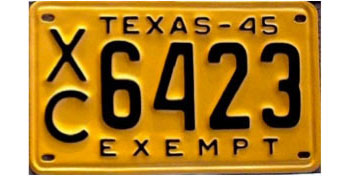 1945 EXEMPT series issue.
1945 EXEMPT series issue. 
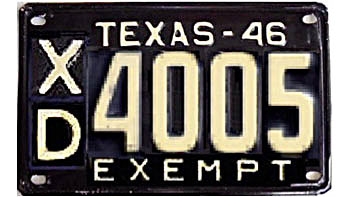 1946 EXEMPT series issue.
1946 EXEMPT series issue. 
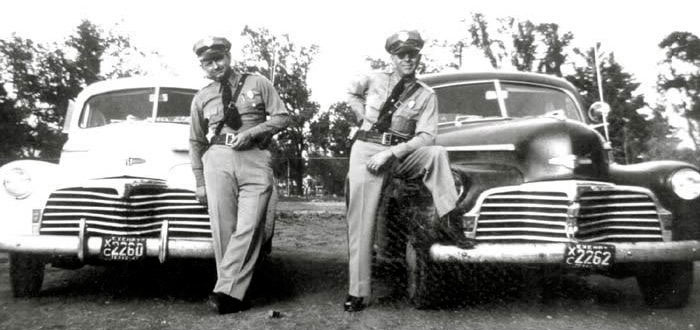
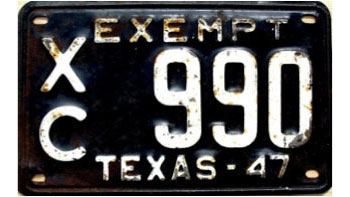 1947 EXEMPT series issue.
1947 EXEMPT series issue. 

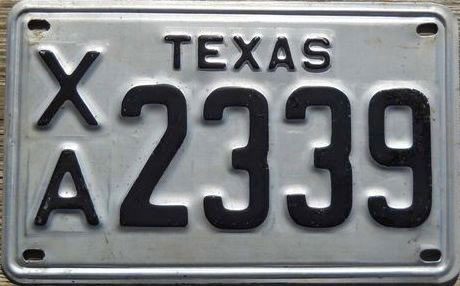 1948 EXEMPT series issue.
1948 EXEMPT series issue. 
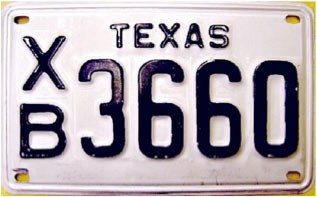 1949 EXEMPT series issue.
1949 EXEMPT series issue. 
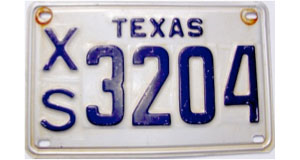 1948-1949 STATE EXEMPT series issue. Embossed aluminum.
1948-1949 STATE EXEMPT series issue. Embossed aluminum.
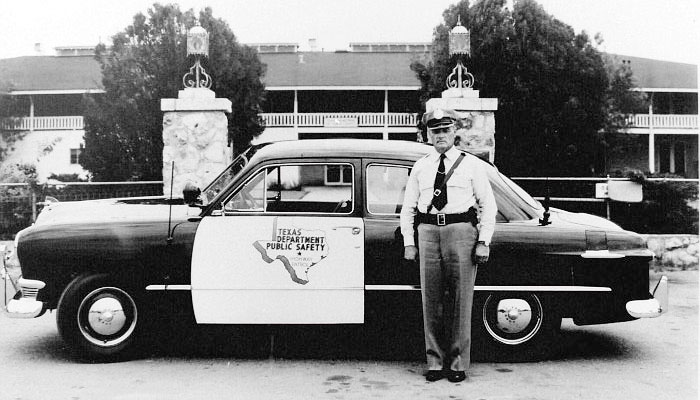
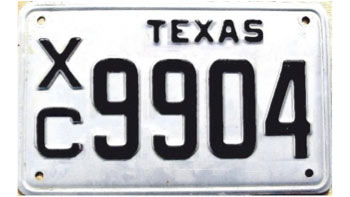 1950 EXEMPT series issue.
1950 EXEMPT series issue. 
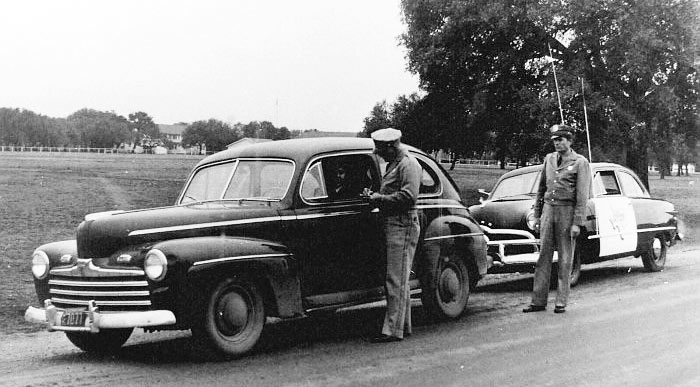
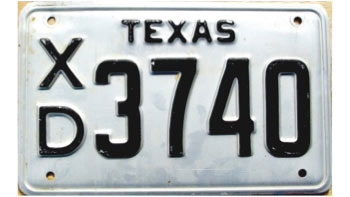 1951 EXEMPT series issue.
1951 EXEMPT series issue. 
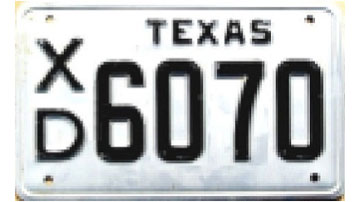 1952 EXEMPT series issue.
1952 EXEMPT series issue. 
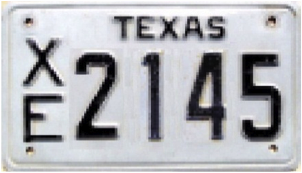 1953 EXEMPT series issue.
1953 EXEMPT series issue. 
 1954 EXEMPT series issue.
1954 EXEMPT series issue. 
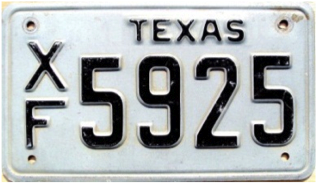 1955 EXEMPT series issue.
1955 EXEMPT series issue. 
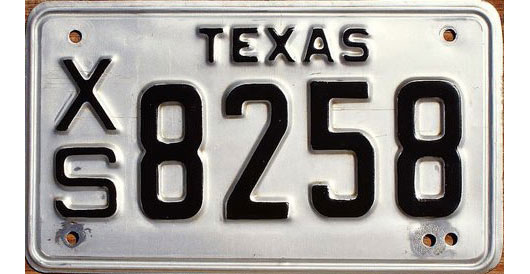 1950-1956 EXEMPT STATE series issue. Embossed aluminum.
1950-1956 EXEMPT STATE series issue. Embossed aluminum.
In 1956 when Texas had to adhere to the new continental 6" x 12" size standard for 4-wheeled and up vehicle license plates, the size and format for license plates used by the Texas DPS/Highway Patrol followed suit. The permanent issue plates still had a black over bare aluminum background, however the prefixes of XA through XF and XS were done-away and replaced with a non-alpha-prefixed number up to five digits as the years progressed. This was to facilitate a generic exempt license plate issuance where the was no differentiation between state exempt and other jurisdictions in the Lone Star State.
The state name TEXAS was embossed at the top center of the plate however slightly offset to the right. A number of four and up to five digits was embossed across the center and EXEMPT was embossed in small font dies at the bottom center of the plate.
These plates were issued until the end of 1960 when another format change took place.
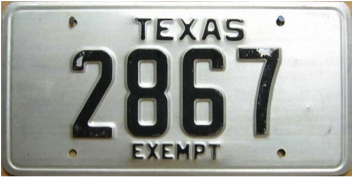 1956 EXEMPT series issue.
1956 EXEMPT series issue. 
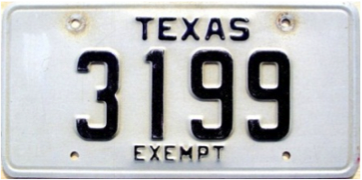 1957 EXEMPT series issue.
1957 EXEMPT series issue. 
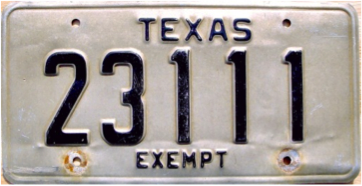 1958 EXEMPT series issue.
1958 EXEMPT series issue. 
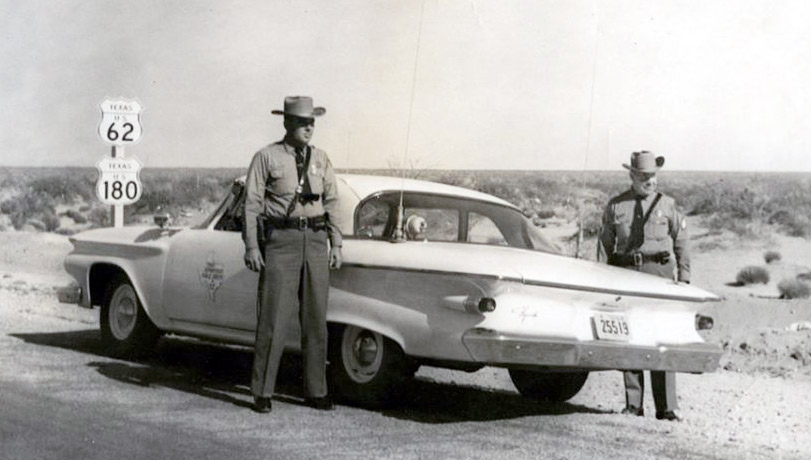 1961 Plymouth with 1959 issue Texas Exempt number.
1961 Plymouth with 1959 issue Texas Exempt number.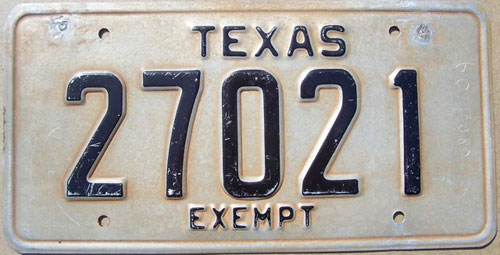 1959 EXEMPT series issue.
1959 EXEMPT series issue. 
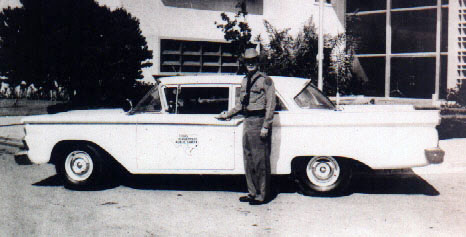
In late 1960, another version of black over aluminum license plate was issued for all exempt vehicles. The state name was embossed in dies that were more elongated and spread-out between the upper mounting holes.
By 1963 the number bloc was separated by a small embossed five-point star.
This base was issued until 1969.
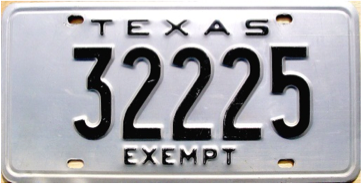 1960 EXEMPT series issue.
1960 EXEMPT series issue. 
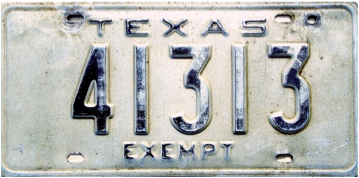 1961 EXEMPT series issue.
1961 EXEMPT series issue. 
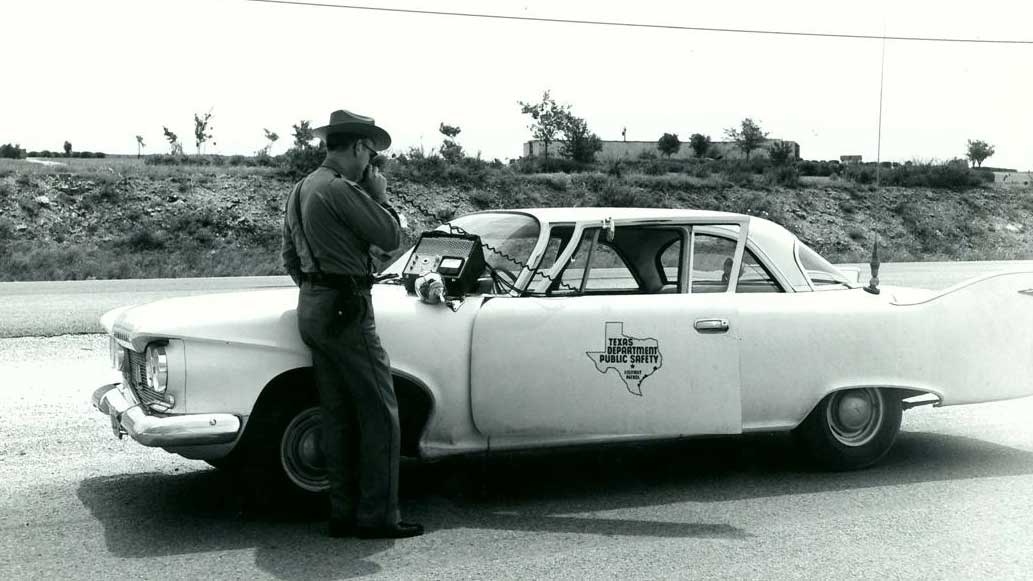 1961. Calling-in.
1961. Calling-in.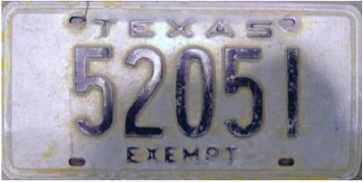 1962 EXEMPT series issue.
1962 EXEMPT series issue. 
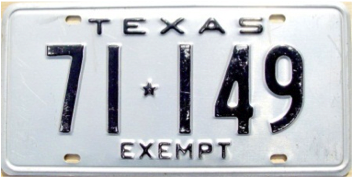 1963 EXEMPT series issue.
1963 EXEMPT series issue. 
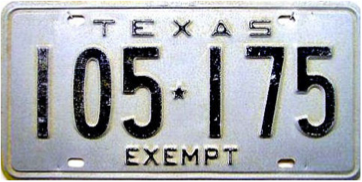 1964 EXEMPT series issue.
1964 EXEMPT series issue. 
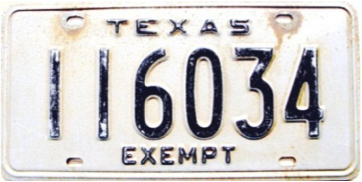 1965 EXEMPT series issue.
1965 EXEMPT series issue. 
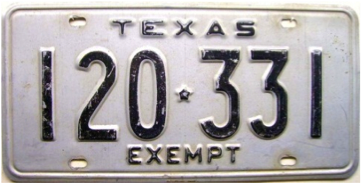 1966 EXEMPT series issue.
1966 EXEMPT series issue. 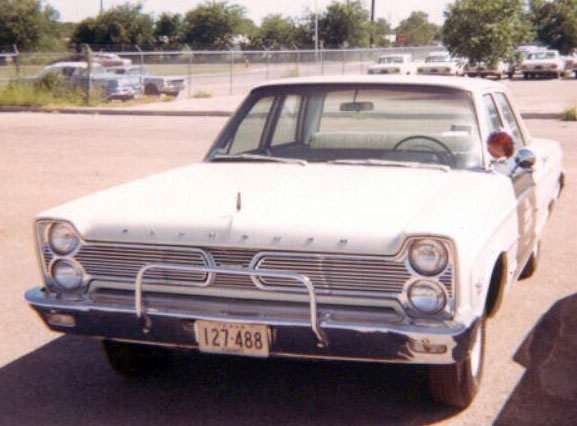 1966 Plymouth with EXEMPT plate in 127 series.
1966 Plymouth with EXEMPT plate in 127 series.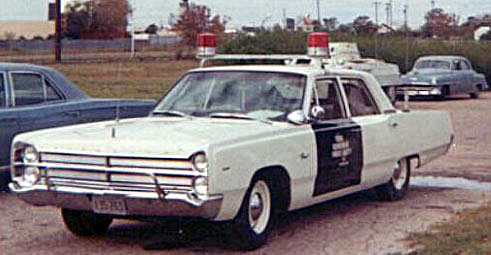
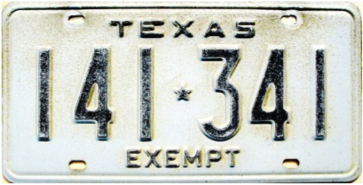 1967 EXEMPT series issue.
1967 EXEMPT series issue. 
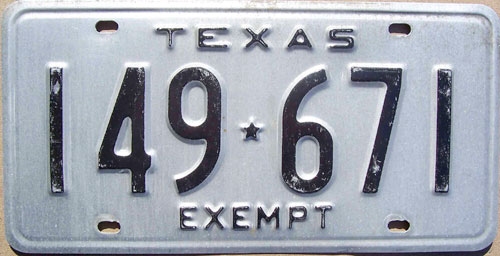 1968 EXEMPT series issue.
1968 EXEMPT series issue. 
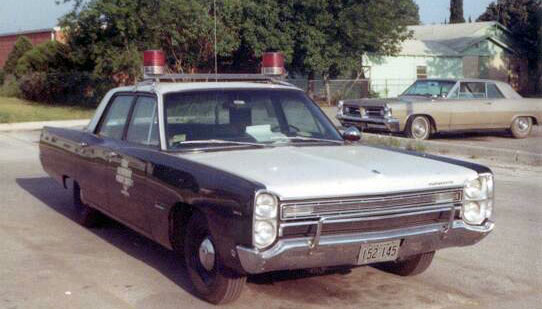
The black over aluminum exempt license plates continued being displayed by Texas DPS/Highway Patrol vehicles into the late 1960's, however it was in 1969 that an identical license plate in layout was made, however the black embossed characters were stamped onto a reflective white background.
The state of Texas described this new background as "silver", as it was covered with 3M Scotchlite sheeting. It is worth noting too, that reflective white background sheeting varied over the course of production runs. Some with a more yellowed tinge and others a brighter white, however all reacted differently to the extended exposure to the elements of the Lone Star State over the course of several years.
This type was issued until a new exempt version was issued in late 1973.
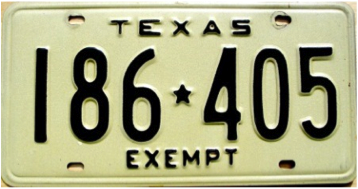 1969 EXEMPT series issue.
1969 EXEMPT series issue. 
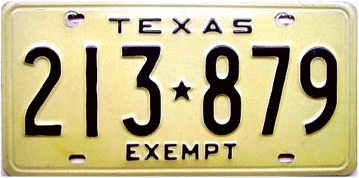 1970 EXEMPT series issue.
1970 EXEMPT series issue. 
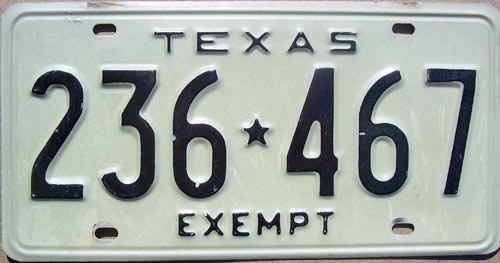 1971 EXEMPT series issue.
1971 EXEMPT series issue. 
 1972 EXEMPT series issue.
1972 EXEMPT series issue. 
As the older exempt plates continued to get used into the early 1970's, they began to truly show their wear from the elements and it was time to commence a general re-issuance of EXEMPT license plates in the Lone Star State.
The new plates followed the same numbering sequence as the previous issue, continued on the black over reflective white ("silver") background and continued to use the 5 point star as a separator between the first three and last three digits of the registration number.
The difference for this new issue was that the title EXEMPT was embossed at the top center of the plate just below the state name, and a step border was used.
In 1974, the last of the 5-point star exempt plates were issued. Texas Exempt license plate number 256-503 was observed on a DPS recruitment vehicle at that time using that type.
Texas Exempt license plate number 272-458 is seen below as an example of the last issuance with the star.
In 1975, a new style of exempt license plate appeared similar to the "star hyphen" plates, but replaced with an embossed state silhouette between the two sets of three numbers.
As time went on, the reflective white background sheeting used on these plates was a brighter white as opposed to the inconsistent backgrounds used prior.
By 1983, this plate used a slight variance in the dies for the words TEXAS and EXEMPT .
There was also a transition from the use of aluminum to galvanized steel to manufacture these plates.
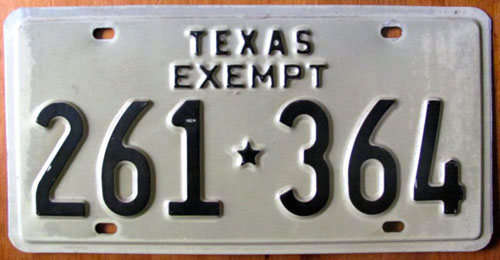 1973-74 EXEMPT series issue.
1973-74 EXEMPT series issue. 
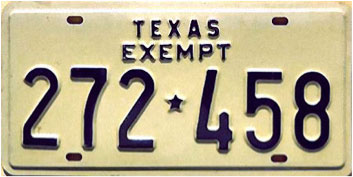 1974 EXEMPT series issue.
1974 EXEMPT series issue. 
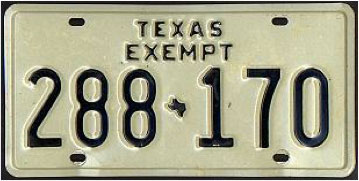 1975 EXEMPT series issue.
1975 EXEMPT series issue. 
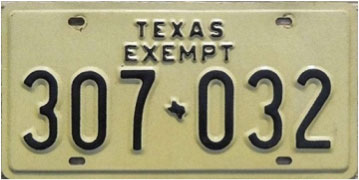 1976 EXEMPT series issue.
1976 EXEMPT series issue. 
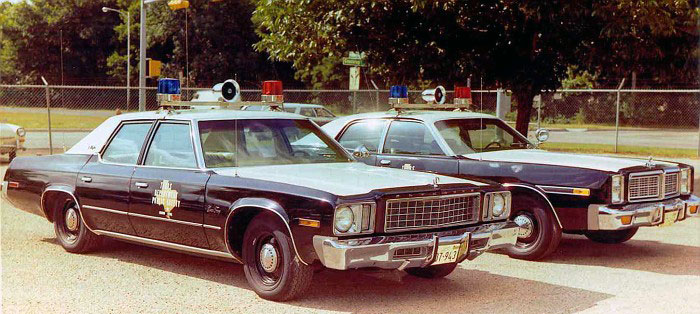
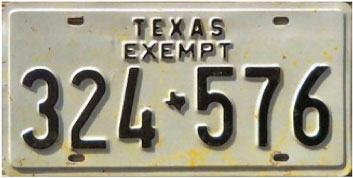 1977 EXEMPT series issue.
1977 EXEMPT series issue. 
 1978 EXEMPT series issue.
1978 EXEMPT series issue. 
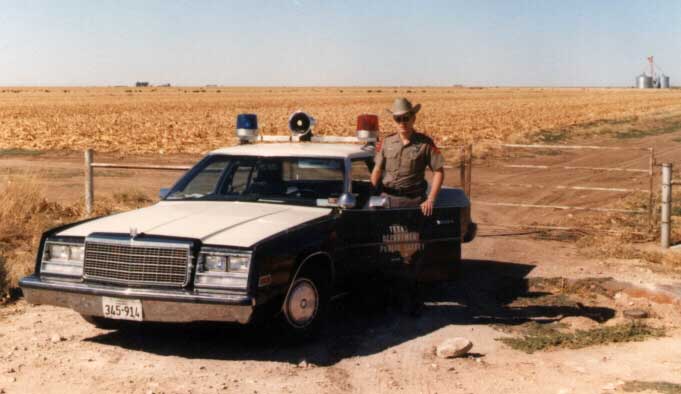 1978
1978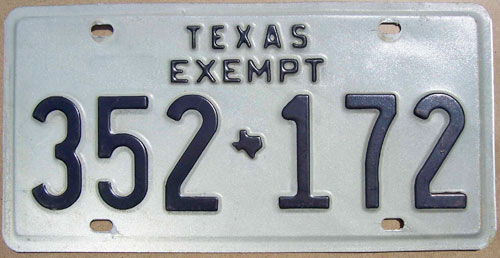 1979 EXEMPT series issue.
1979 EXEMPT series issue. 
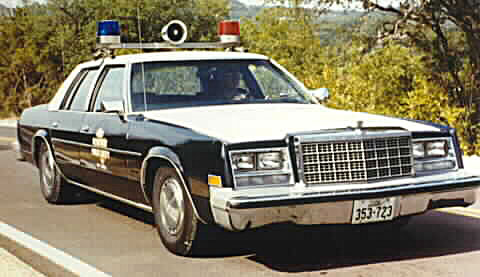
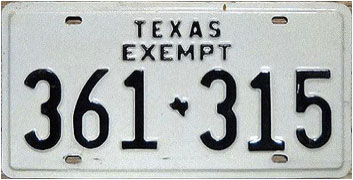 1980 EXEMPT series issue.
1980 EXEMPT series issue. 
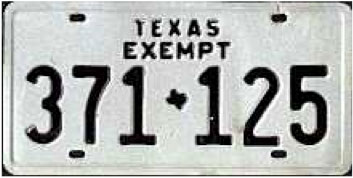 1981 EXEMPT series issue.
1981 EXEMPT series issue. 
 1983 EXEMPT series issue.
1983 EXEMPT series issue. 
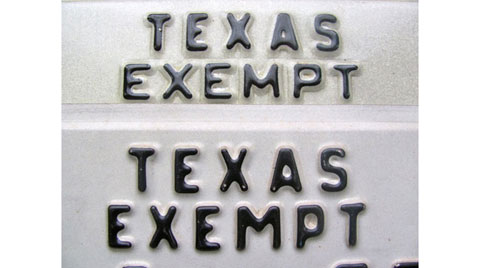 The image shows the slight difference between the dies used from 1973 to 1982 (top) and 1983 to 2005 (bottom).
The image shows the slight difference between the dies used from 1973 to 1982 (top) and 1983 to 2005 (bottom).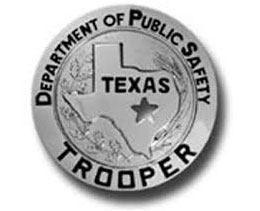
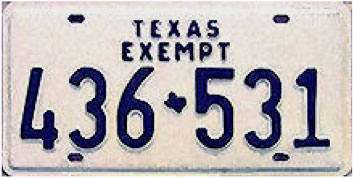 1984 EXEMPT series issue.
1984 EXEMPT series issue. 
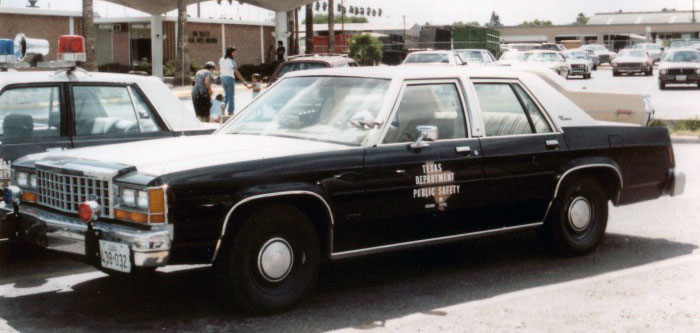
 1985 EXEMPT series issue.
1985 EXEMPT series issue. 
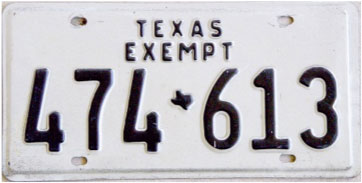 1987 EXEMPT series issue.
1987 EXEMPT series issue. 
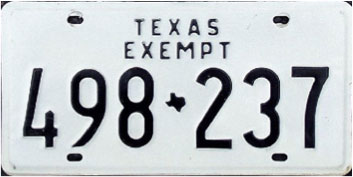 1988 EXEMPT series issue.
1988 EXEMPT series issue. 
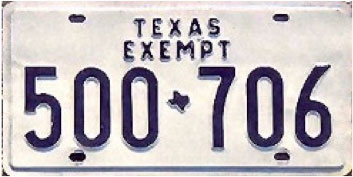 1989 EXEMPT series issue.
1989 EXEMPT series issue. 
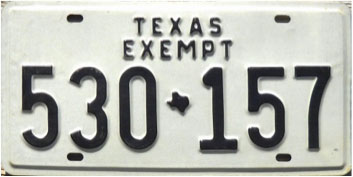 1990 EXEMPT series issue.
1990 EXEMPT series issue. 
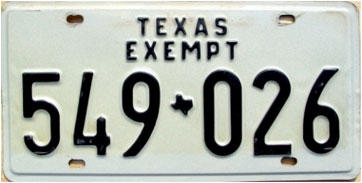 1991 EXEMPT series issue.
1991 EXEMPT series issue. 

 1992 EXEMPT series issue.
1992 EXEMPT series issue. 
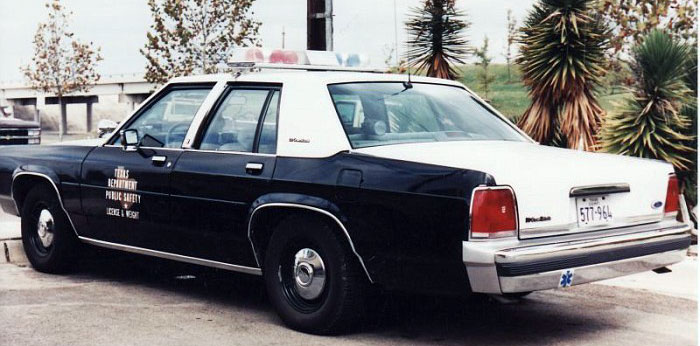
 1993 EXEMPT series issue.
1993 EXEMPT series issue. 
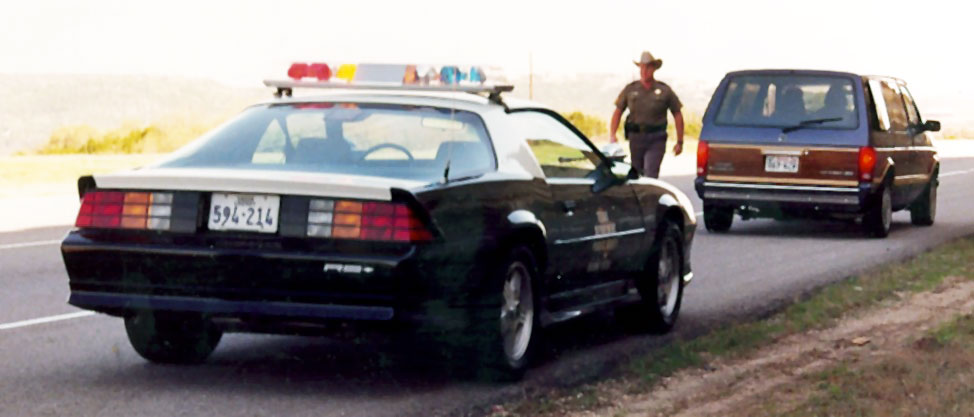
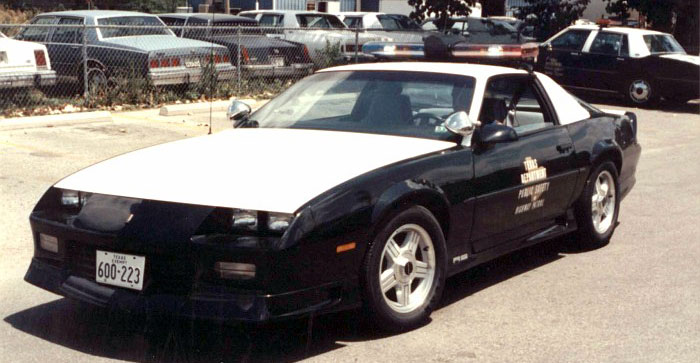
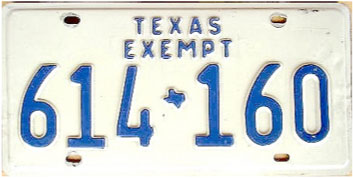 1994 EXEMPT series issue.
1994 EXEMPT series issue. 
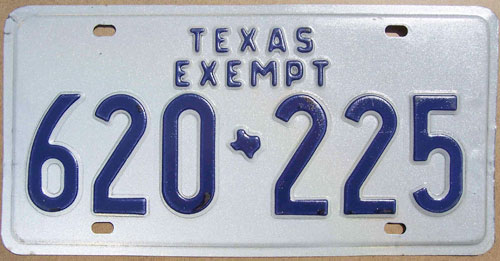 1995 EXEMPT series issue.
1995 EXEMPT series issue. 
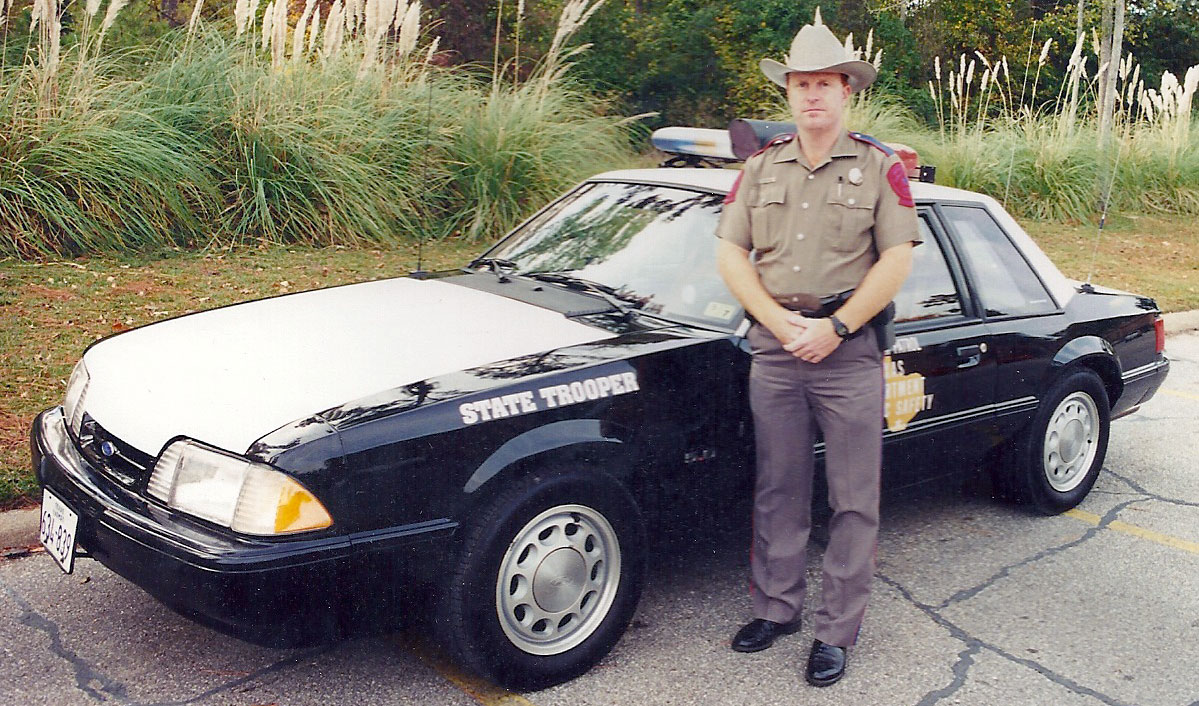
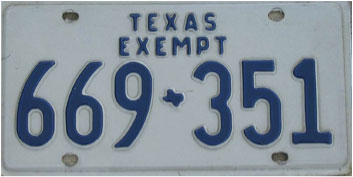 1996 EXEMPT series issue.
1996 EXEMPT series issue. 
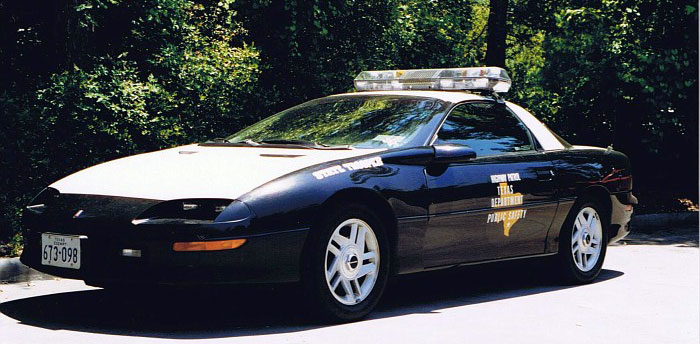
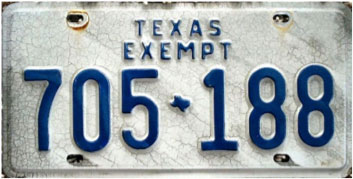 1997 EXEMPT series issue.
1997 EXEMPT series issue. 
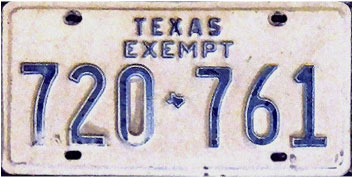 1998 EXEMPT series issue.
1998 EXEMPT series issue. 
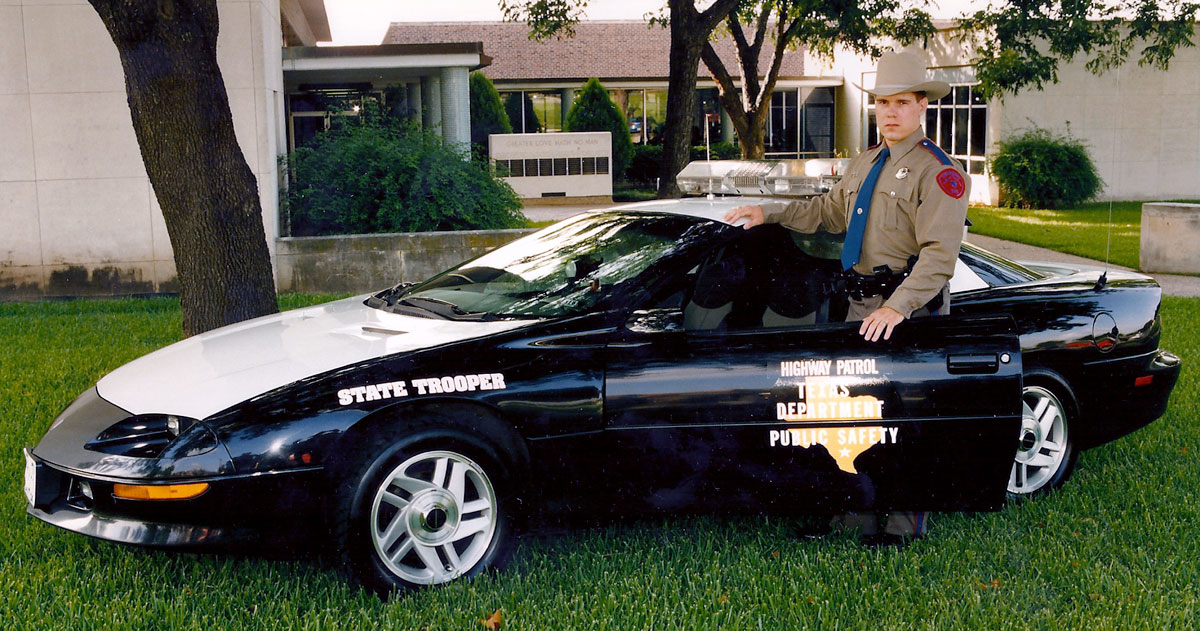
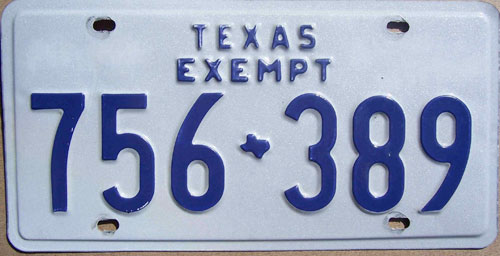 2000 EXEMPT series issue.
2000 EXEMPT series issue. 
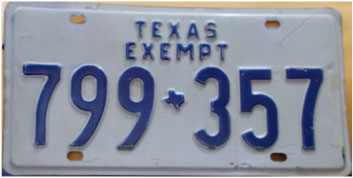 2001 EXEMPT series issue.
2001 EXEMPT series issue. 
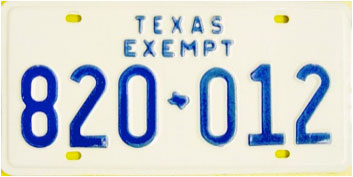 2001-2002 EXEMPT series issue. Embossed aluminum.
2001-2002 EXEMPT series issue. Embossed aluminum.
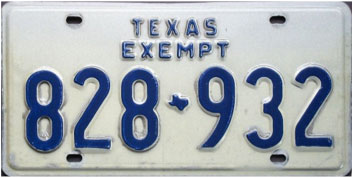 2002 EXEMPT series issue.
2002 EXEMPT series issue. 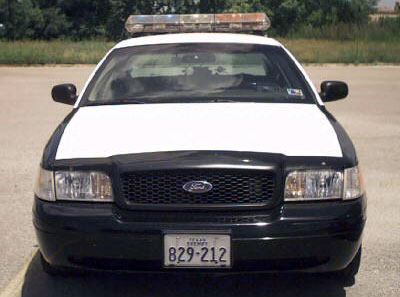
In 2001-2002, somewhere in the 830-000 series, a new version of the Texas Exempt license plate was unveiled. The plate was similar in construction and layout as the previous issue, and the numbering sequence continued uninterrupted. The significant change however, was that the state name and the state silhouette were silkscreened in red. These plates continued being issued in some parts of the state through 2006.
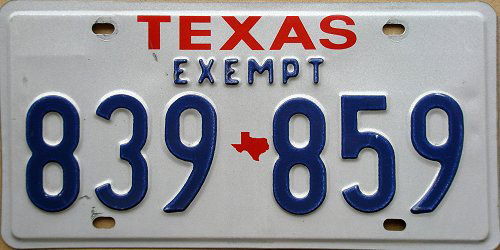 2001-2002 EXEMPT series issue. Embossed aluminum.
2001-2002 EXEMPT series issue. Embossed aluminum.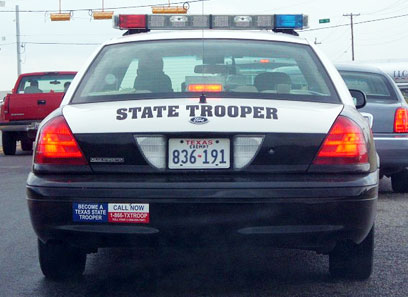 (Courtesy Paolo Valchi)
(Courtesy Paolo Valchi)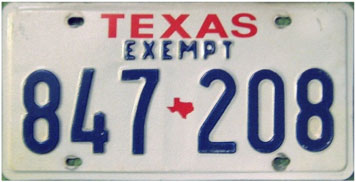 2001-2002 EXEMPT series issue. Embossed aluminum.
2001-2002 EXEMPT series issue. Embossed aluminum.
In late 2002/early 2003, Texas Exempt license plates began being manufactured using all-silkscreened characters including the registration number. The only embossing would be the step border on the galvanized steel plate.
The state name was silkscreened in large blue font at the top center of the plate with EXEMPT screened in smaller red font just below it.
The registration number was screened in dark blue with the state silhouette being used once again as a hyphen between the two sets of three numbers. A small bar code was screened in the bottom right corner margin of the plate.
It was on the later version of this base where a small graphic "map" of the state was added to the top right corner of the plate which was now made of aluminum again.
It was also on this later base that the numbering began again in the 200 000 series.
These plates were used until the Texas Highway Patrol got their own agency-specific license plates in late 2005.
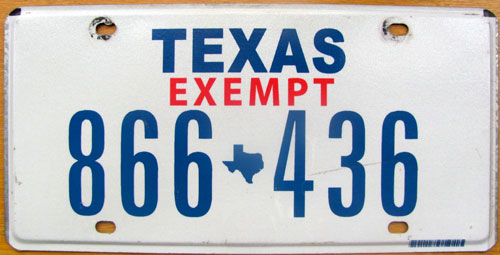 2002-2006 EXEMPT series issue. Embossed aluminum.
2002-2006 EXEMPT series issue. Embossed aluminum.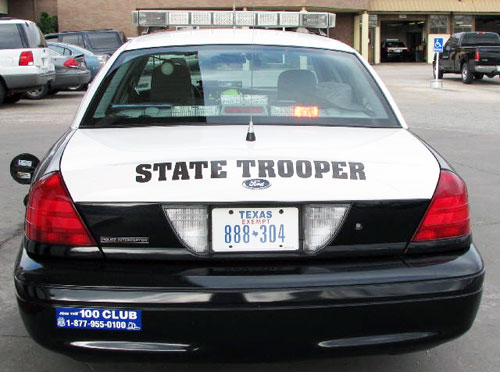
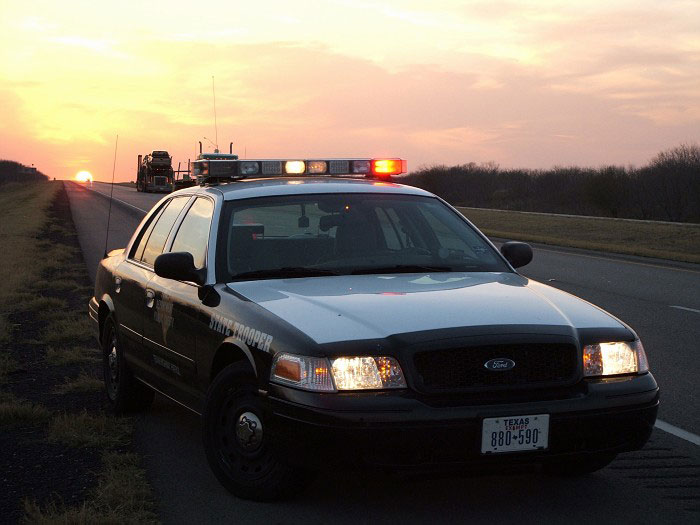
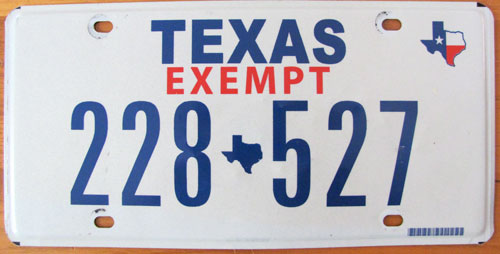 2007 standard Exempt issue. Silkscreened aluminum.
2007 standard Exempt issue. Silkscreened aluminum.
In late 2005, something great happened for the Texas Highway Patrol. They were issued with their very first agency-specific graphic license plates. Known as "the patch plate" due to its large full-color silkscreened emblem which occupied the entire left center field of the plate and centered between the upper and lower left mounting holes. The state name was silkscreened in dark blue bold capital font at the top center of the plate. The registration number consists of five digits including lead zeroes also screened in blue. TEXAS HIGHWAY PATROL is silkscreened in black along the bottom center of the plate between the lower mounting holes. A red/white/blue state emblem was screened in the top left corner with EXEMPT screened in red just below it.
A small blue bar code is situated at the bottom right corner just above the crease of the step border.
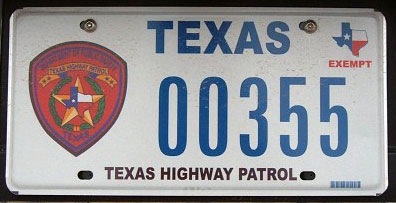 2005-2016 issue.
2005-2016 issue. 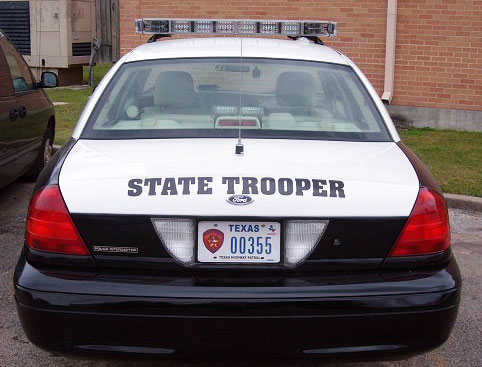
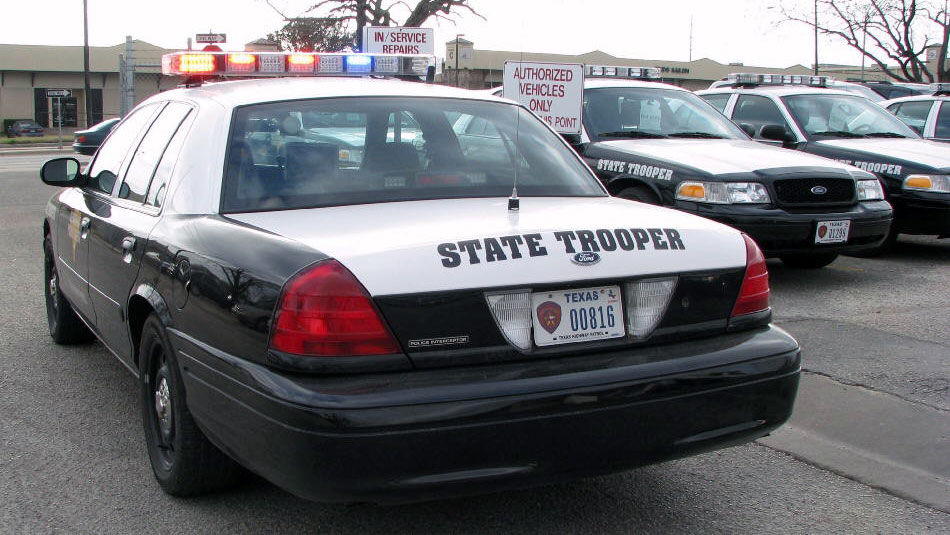
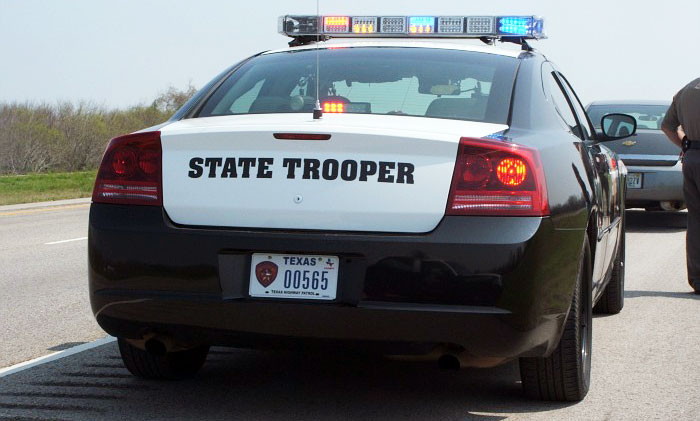
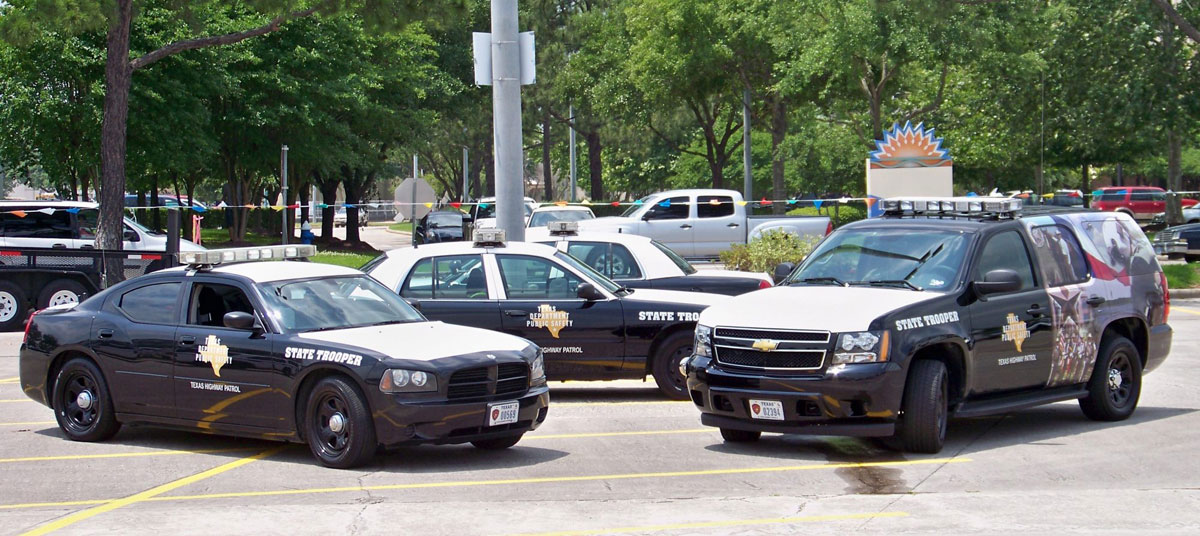
Sometime around 2016, a change to the appearance of the Texas Highway Patrol license plates took place. The state name and numerals were changed from blue to black and the state flag/state shape EXEMPT emblem in the top right corner was replaced with a stylized black and white 5-point star with EXEMPT inscribed below it.
In fact, the photo below from Sgt. Ryan McKittrick shows that the change from the blue character base to the black was at the numbers 06624 and 06625.
By March of 2020, the registration numbers were up to the 8300 series.
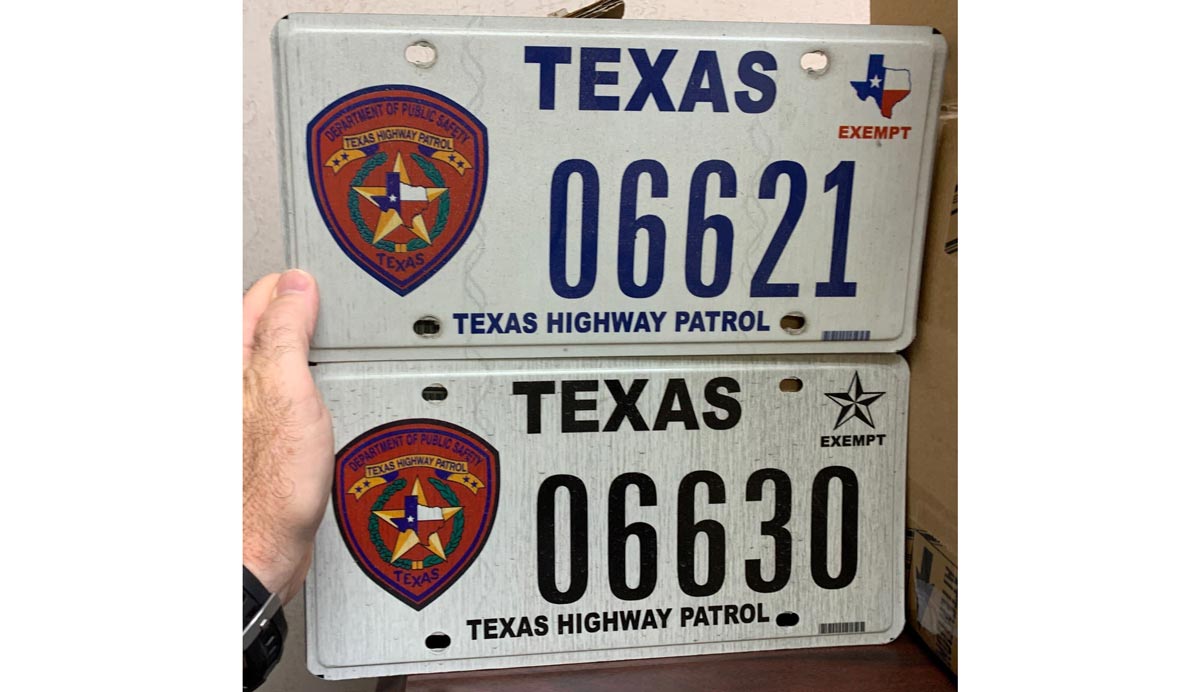 Photo from Texas Highway Patrol Sgt Ryan E. McKittrick showing that the switch-over from the blue character base plate to the black in 2016 happened between numbers 06624 and 06625.
Photo from Texas Highway Patrol Sgt Ryan E. McKittrick showing that the switch-over from the blue character base plate to the black in 2016 happened between numbers 06624 and 06625.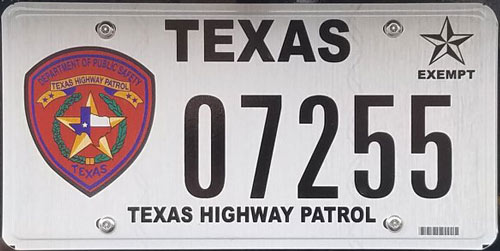 2016-Current issue. Black over white.
2016-Current issue. Black over white.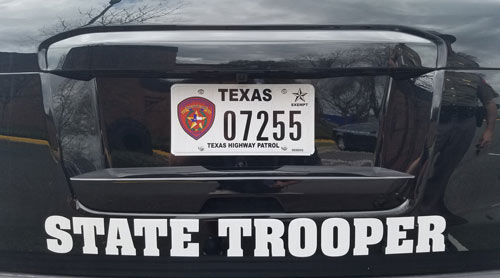
 Off-road delight.
Off-road delight.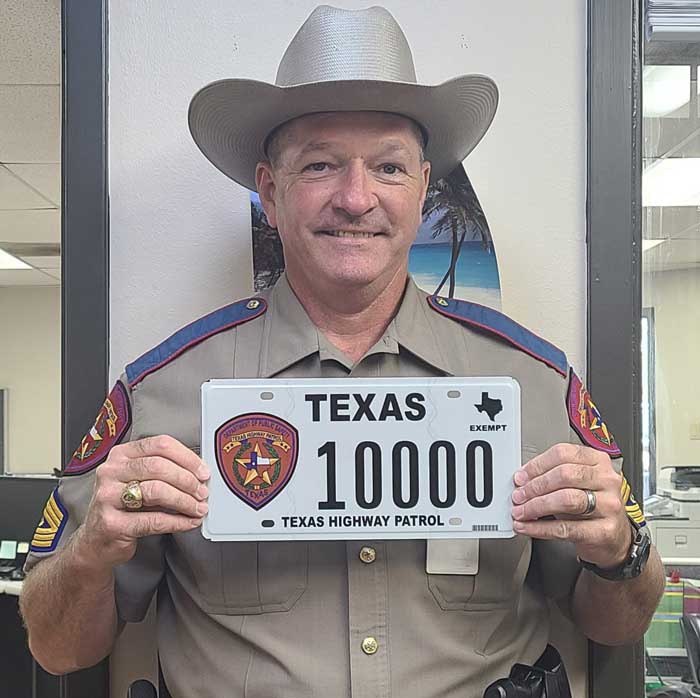 Texas DPS/HP S/Sgt Ryan McKittrick showing that as of April of 2022, Texas HP license plates have hit the 10000 mark.
Texas DPS/HP S/Sgt Ryan McKittrick showing that as of April of 2022, Texas HP license plates have hit the 10000 mark.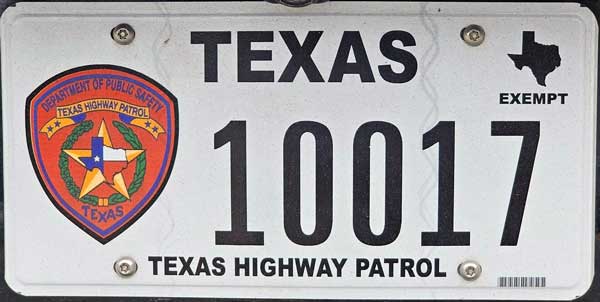 2022-Current issue.
2022-Current issue.There is no definitive record of the history of license plate used on the motorcycles of the Texas DPS/Highway Patrol. The period photographs also seem to show every angle of the motorcycle with the exception of the rear where the license plate would be attached.
Municipal and county law enforcement motorcycles during the early years utilized a mixture of exempt and regular motorcycle license plates.
For the purposes of this archive, we will showcase Texas motorcycle exempt license plates as a likely hypothesis as to the type of license plates used by the THP cycles during those years.
As with some of the other Texas exempt license plate examples shown above, our thanks go to Don Cantello for providing photos and information of these types.

 1932 Motorcycle Exempt side car issue. Embossed steel.
1932 Motorcycle Exempt side car issue. Embossed steel.
 1933 Motorcycle Exempt issue. Embossed steel.
1933 Motorcycle Exempt issue. Embossed steel.
 1934 Motorcycle Exempt issue. Embossed steel.
1934 Motorcycle Exempt issue. Embossed steel.
 Back when Training Day was TRAINING DAY!
Back when Training Day was TRAINING DAY! 1935 Motorcycle Exempt issue. Embossed steel.
1935 Motorcycle Exempt issue. Embossed steel.
1936: Embossed steel. Approx. 3 5/8" x 7 1/2". Cream over maroon. 36 (stacked left) X (star) number up to 3 digits, TEX (stacked right) over MOTORCYCLE.
1937: Embossed steel. Approx. 3 5/8" x 7 1/2". Maroon over light gray. MOTORCYCLE over TEX (stacked left) X (star) number up to 3 digits (star), 37 (stacked right)
 1938 Motorcycle Exempt issue. Embossed steel.
1938 Motorcycle Exempt issue. Embossed steel.

1939: Embossed steel. Approx. 3 3/4" x 7 1/2". Yellow-orange "gold" over black. MOTORCYCLE over TEX (stacked left) X (star) number up to 3 digits 39 (stacked right).
1940: Embossed steel. Approx. 3 5/8" x 7 1/2". Dark purple over yellow-orange "gold". MOTORCYCLE over TEX (stacked left) X (star) number up to 3 digits 40 (stacked right).
1941: Embossed steel. Approx. 3 3/4" x 7 1/2". Black over yellow-orange "gold". TEXAS 1941 over M/C (stacked left) X (dash) number up to 3 digits.
 1942 Motorcycle Exempt issue. Embossed steel.
1942 Motorcycle Exempt issue. Embossed steel.
 1943 Motorcycle Exempt issue tab. Embossed steel.
1943 Motorcycle Exempt issue tab. Embossed steel.
 1944 Motorcycle Exempt issue tab. Embossed steel.
1944 Motorcycle Exempt issue tab. Embossed steel.
 1945 Motorcycle Exempt issue. Embossed steel.
1945 Motorcycle Exempt issue. Embossed steel.
1946: Embossed steel. Approx. 3 3/4" x 7 1/2". Cream over black (unconfirmed). ZX (stacked left) TEX-46 over number up to 3 digits.
1947: Embossed steel. Approx. 3 3/4" x 7 1/2". White over black (unconfirmed). ZX (stacked left) TEX-47 over number up to 3 digits.
1948: Embossed steel. Approx. 3 3/4" x 7 1/2". Yellow-orange "gold" over black (unconfirmed). YX (stacked left) TEX-48 over number up to 3 digits.
1949: Embossed steel. Approx. 3 3/4" x 7 1/2". Black over yellow-orange "gold" (unconfirmed). YX (stacked left) TEX-49 over number up to 3 digits.
1950: Embossed steel. Approx. 3 3/4" x 7 1/2". Yellow-orange "gold" over black (unconfirmed). YX (stacked left) TEX-50 over number up to 3 digits.
1951: Embossed steel. Approx. 3 3/4" x 7 1/2". Black over yellow-orange "gold" (unconfirmed). YX (stacked left) TEX-51 over number up to 3 digits.
1952: Embossed steel. Approx. 3 3/4" x 7 1/2". Yellow-orange "gold" over black (unconfirmed). YX (stacked left) TEX-52 over number up to 3 digits.
1953: Embossed steel. Approx. 3 3/4" x 7 1/2". Black over yellow-orange "gold" (unconfirmed). YX (stacked left) TEX-53 over number up to 3 digits.
1954: Embossed steel. Approx. 3 3/4" x 7 1/2". Yellow-orange "gold" over black (unconfirmed). YX (stacked left) TEX-54 over number up to 3 digits.
 1955 Motorcycle Exempt issue. Embossed steel.
1955 Motorcycle Exempt issue. Embossed steel.
 1956-1960's Motorcycle Exempt issue. Embossed aluminum.
1956-1960's Motorcycle Exempt issue. Embossed aluminum.
During the period from 1956 to 1965, it is believed but not confirmed that Texas DPS/Highway Patrol motorcycles used the black over aluminum 3" x 5 1/2" XY prefixed license plates. In 1966, the format and color scheme for Texas exempt motorcycle license plates continued, however the dimensions changed to 3" x 5 1/2". By 1968, that dimension then went to 4" x 7".
In 1969, Texas exempt motorcycle license plates went to a reflective white ("Silver") background with black embossed characters. TEXAS was embossed at the top center of the plate and MOTORCYCLE was embossed at the bottom center.
A four-digit number prefixed by XY occupied the center of the plate. It is believed that this series began in the 3000 number bloc in 1969, and like the "car plates" used by the Texas DPS/Highway Patrol, followed sequentailly over the years.
 1960's-1970's Motorcycle Exempt issue.
1960's-1970's Motorcycle Exempt issue. 
 1960's-1970's Motorcycle Exempt issue.
1960's-1970's Motorcycle Exempt issue. 
 1960's-1970's Motorcycle Exempt issue.
1960's-1970's Motorcycle Exempt issue. 
 1960's-1970's Motorcycle Exempt issue.
1960's-1970's Motorcycle Exempt issue. 
 1960's-1970's Motorcycle Exempt issue.
1960's-1970's Motorcycle Exempt issue. 
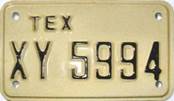 1960's-1970's Motorcycle Exempt issue.
1960's-1970's Motorcycle Exempt issue. 
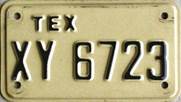 1960's-1970's Motorcycle Exempt issue.
1960's-1970's Motorcycle Exempt issue. 
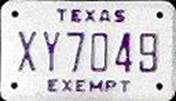 1980's-1990's Motorcycle Exempt issue.
1980's-1990's Motorcycle Exempt issue. 
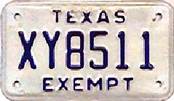 1980's-1990's Motorcycle Exempt issue.
1980's-1990's Motorcycle Exempt issue. 
 1990's-2000's Motorcycle Exempt issue.
1990's-2000's Motorcycle Exempt issue. 
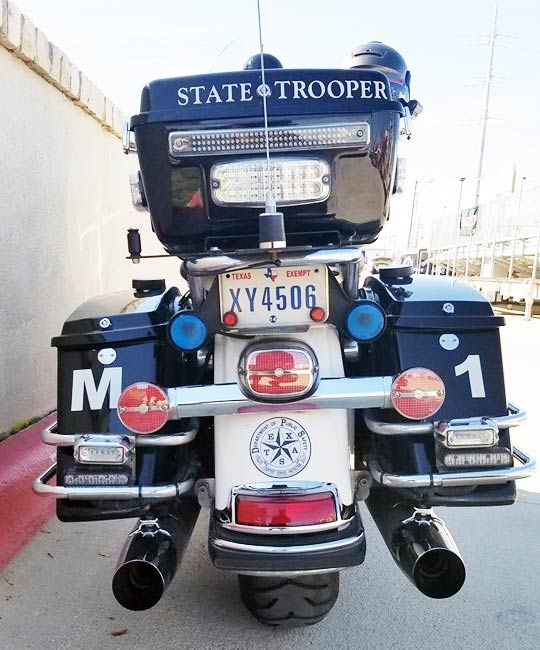 2018-All silkscreened.
2018-All silkscreened.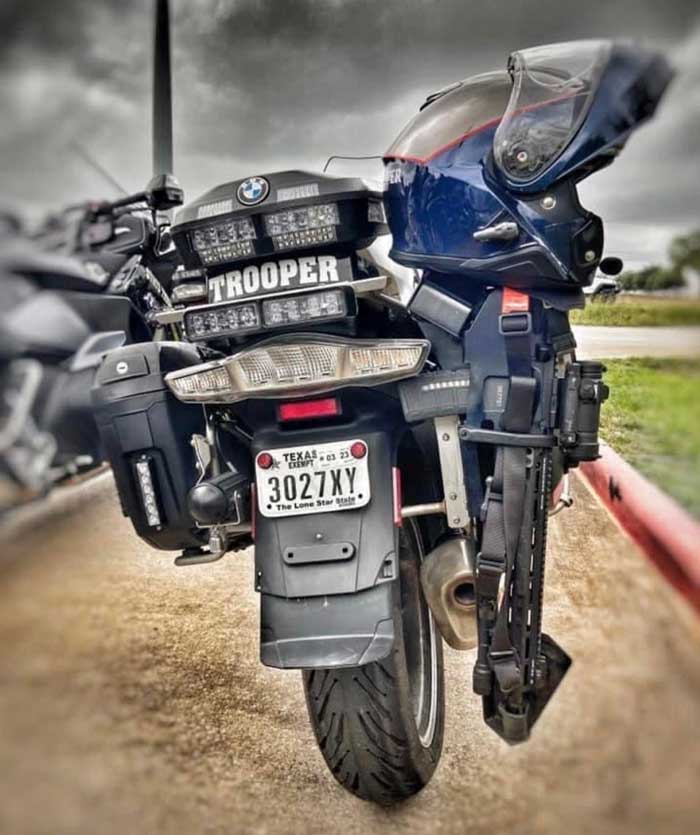 2022- All silkscreened.
2022- All silkscreened.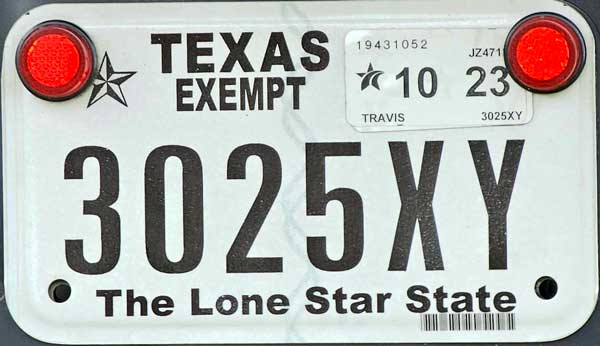 2014-Current Exempt motorcycle.
2014-Current Exempt motorcycle.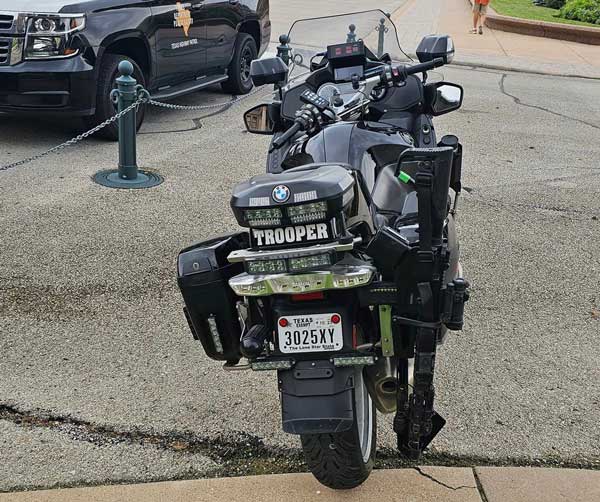 (Courtesy Guillaume Joseph)
(Courtesy Guillaume Joseph) Some specialty use license plates were made as souvenir license plates attributed to the Texas DPS/Highway Patrol.
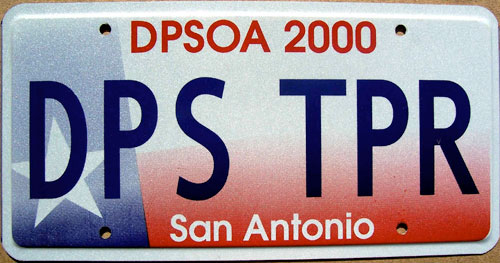 Souvenir license plate given to attending delegates to the Department of Public Safety Officers Association conference which took place in San Antonio TX in 2000.
Souvenir license plate given to attending delegates to the Department of Public Safety Officers Association conference which took place in San Antonio TX in 2000.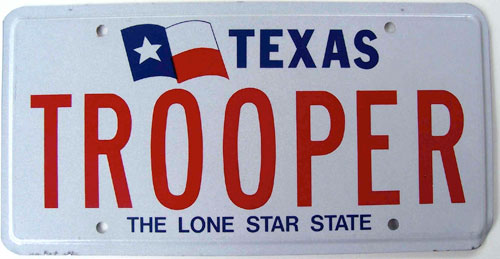 Souvenir license plate given to attending delegates to the National Troopers Coaliton conference. Year unknown.
Souvenir license plate given to attending delegates to the National Troopers Coaliton conference. Year unknown.